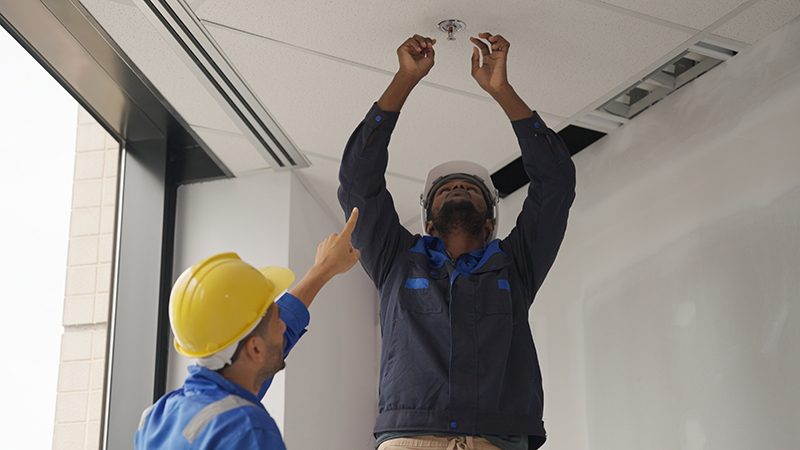
THE Chief Executive Officer of the British Automatic Fire Sprinkler Association (BAFSA) has suggested the UK’s ongoing response to RAAC could be used as an economical way of installing sprinklers in school buildings in England.
Acknowledging that Scotland is in a ‘reasonable position’ in regard to its sprinkler legislation – with the fire protection system being mandatory in all new post-2021 flats, schools, and care homes – Alasdair Perry hopes the installations can be extended to hotels, historic buildings being converted to new uses, older care homes, and warehouses below the current threshold of 14,000m2.
Alasdair became CEO of BAFSA in 2023, a day after retiring from a 29-year career in the Scottish Fire and Rescue Service where he held roles on the frontline, as well as deputy assistant chief officer in the role of head of prevention and protection for the last four years of his tenure.
In response to Scotland’s residential fire deaths almost doubling in 2020, Alasdair spearheaded the launch of a campaign focused around alerting the fire service to individuals at risk – due to characteristics including age, mobility issues, and habits. With it helping to reduce deaths by 20% the following year, he was intent on going a step further – with sprinklers playing a key role.
Alasdair made the decision to take up the role of BAFSA CEO to continue his goal of better protecting vulnerable people from fires, as well as the wider built environment, and also improving the safety of firefighters.
Having tragically lost two colleagues in service during his career, Alasdair explained that sprinklers often allow firefighters to enter a safer environment with less smoke, heat, and fire spread – allowing them to extinguish the fire and get people out.
A study by America’s National Fire Protection Association, which focused on fires from 2017-2021, compared blazes in buildings with no automatic extinguishing systems to fires in those with sprinklers – finding that civilian death and injury rates fell by 90% and 32% respectively in sprinklered buildings, with firefighter injuries being 35% lower. Property damage stood at $249 million, compared to the $1.2 billion in those without such systems.
Following a fatal accident inquiry into the fire at Cameron House hotel, the Royal Incorporation of Architects in Scotland (RIAS) called for the retrospective installation of sprinkler systems in all buildings used by the general public. Despite this, there is no such legislation in place for hotels, converted historic buildings, warehouses below 14,000m2, and care homes built prior to 2005.
Despite studies showing a safety and potential cost saving through the installation of sprinklers, some building owners are believed to be shunning the safety system due to a lack of knowledge on how sprinklers actually work.
“Hollywood and TV have a significant reach and the biggest misconception without a doubt is that sprinklers all go off at once,” Alasdair told Project Scotland, before citing the scene in Die Hard where a lighter is held to a sprinkler causing all of the sprinklers in the building to go off.
“That’s not the way it works. The glass bulb within a sprinkler above a fire will expand and, at a certain temperature, that bulb will burst and allow the water to come through. There’s no way of getting them all to operate; it’s just the one that needs to operate above the fire, and if the heat grows and spreads the sprinkler next to it will operate.”
Another stumbling block is cost, with it generally being more expensive to install sprinklers in existing buildings than new ones. A 2021 FOI request found just 8.5% of new and 14.5% of majorly refurbished schools in England had sprinklers installed – which coincided by findings by education insurer, Zurich, revealing English schools were twice as likely to suffer a blaze as other commercial buildings, with the average cost of repair being £2.8 million.
Acknowledging the cost of installing sprinklers in existing buildings, Alasdair believes the response to RAAC could present an opportunity to make cost savings and ensure the fire protection system is present in older builds.
“RAAC needs to be remedied and there’s a huge amount of money being spent to remedy it, but why not fit sprinklers at the same time? We regularly see instances of school fires where parts or whole schools are destroyed. Money has been set aside to reduce the risk of collapse (because of RAAC), and with a little more spent we could see sprinklers fitted as well. Sprinklers are cheaper if you fit them whilst doing other work.”
Despite there being older buildings in Scotland without sprinklers, Alasdair insists the country is in a reasonable position in terms of fire safety – with the nation’s extensive school build and refurbishment programme ensuring most are sprinklered.
“In Wales all new homes require sprinklers; in Scotland it’s all new flats. That’s fantastic from a Scottish point of view,” Alasdair continued. “We are in a reasonable position; we could improve, and we need to improve, but we are in a reasonable position.”
To target improvements across the UK, BAFSA has developed a free Automatic Fire Suppression Systems course, which Alasdair said takes around two hours to complete and is designed for members of a public with an interest in sprinklers and professionals working alongside fire safety specialists, such as architects and building control experts, to better understand the life-saving equipment.
• For more information on the course, visit: https://bafsa.mic.eu.com/course/1147bfcf6d407aab/sprinkler-saves.aspx#Training%20Centre










